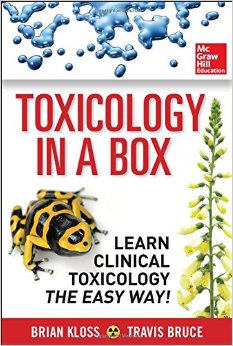Toxicology in a box is a pretty cool toxicology learning tool. The box contains 154 flashcards with classic and memorable drawings of important poisonings and toxidromes. On the reverse of each card, there is additional important information about sources, classic scenarios, signs/symptoms, mechanisms of action, treatment and clinical pearls. The cards are hilarious (sometimes!) and memorable. It’s really hard to forget the “superwarfarin” card, for example: a rodent with a cape bleeding from every orifice, including those marked “censored” (for obviously sentimental reasons). Arsenic poisoning is, of course, not funny, but a rat with garlic breath who is wearing a bikini is funny (only if you’re into that kind of humor). As another reviewer so eloquently understated it: “Thank God you have avoided the cuteness trap.”
The cards are hilarious (sometimes!) and memorable. It’s really hard to forget the “superwarfarin” card, for example: a rodent with a cape bleeding from every orifice, including those marked “censored” (for obviously sentimental reasons). Arsenic poisoning is, of course, not funny, but a rat with garlic breath who is wearing a bikini is funny (only if you’re into that kind of humor). As another reviewer so eloquently understated it: “Thank God you have avoided the cuteness trap.”
Unfortunately, some of the “classic scenario” are too classic, and the workup section, which is arguably the most important section, seems to be missing altogether. For example, the Ethylene Glycol card says:
“Classic Scenario: A child is brought in with confusion, vomiting, tachycardia, hyperventilation and muscle spasms after ingesting antifreeze.” (p. 87)
Or, in the case of isoniazid poisoning:
“A 5-year old immigrant child with no past medical history presents to the ED with [refractory] seizures. The family offers an empty bottle of INH as a possible ingestion.” (p. 96)
While these are indeed classic scenarios, they are far too easy and too classic: you don’t have to diagnose anything here because the authors are diagnosing these cases for you! In future editions, it would be better to describe the cases in a way that requires some thinking: for example, in the ethylene glycol case, “A toddler is brought in with confusion, vomiting, tachycardia, hyperventilation, muscle spasms and florescent urine [or hematuria, or crystalluria]. He’s been hanging around in the garage where his perpetually drunk father has been working on his numerous cars.” In addition, there should be a separate workup section. For suspected ethylene glycol poisoning, a suggested workup might consist of serum electrolytes and osmolarity, urinalysis, and examination of the urine or vomitus with ultraviolet light. In the case of isoniazid poisoning, one should consider ordering a blood count (because of possible hemolysis, eosinophilia) serum electrolytes (high anion gap metabolic acidosis), lactic acid, and liver chemistries (hepatotoxicity).
In any event, toxicology in a box is a cool learning tool that will help you enjoy and remember toxicology.


Leave a Reply